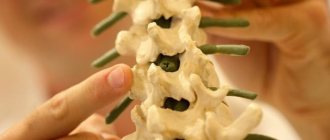A sedentary lifestyle is the scourge of our time. Lack of movement provokes the development of a huge number of diseases, among which the leading positions are occupied by pathologies of the musculoskeletal system and especially the spine. The disorders progress slowly and initially do not manifest themselves in any way. The first symptoms usually occur when the disease has already led to significant changes requiring immediate medical intervention.
As part of the conservative treatment of spinal diseases and the prevention of their development, people are often prescribed physical therapy or exercise therapy. Often it is one of the components of complex treatment and is complemented by physiotherapy, manual therapy and drug treatment.
What is exercise therapy
Therapeutic exercise involves an individually selected set of exercises to prevent the development of degenerative-dystrophic processes in the spine or stop the progression of existing ones. Exercise therapy classes are simple, accessible to people of any age, do not require much time and can usually be performed at home.
Patients are prescribed a set of exercises selected in accordance with their age, type and characteristics of the disease, level of general physical fitness and a number of other factors. Depending on the goals pursued, all recommended exercises can be divided into 3 groups:
- for decompression – they involve stretching the spine in order to increase the spaces between the vertebrae and eliminate the pressure of anatomical structures on the nerve endings;
- to increase mobility - aimed at increasing the flexibility of the spine, reducing the likelihood of strangulation of hernias, nerves and blood vessels, as well as eliminating muscle spasm;
- to strengthen the muscular-ligamentous apparatus - help to increase muscle strength and strengthen the muscle corset, which can create reliable support for the spine and reduce the load on it.
Therapeutic exercise is useful both for a completely healthy person and for people who have already been diagnosed with a particular spinal disease. In all cases, it is called upon:
- eliminate or at least reduce back pain resulting from compression of the nerve roots;
- strengthen the muscle corset;
- eliminate increased pressure of the vertebrae on the intervertebral discs;
- accelerate the course of metabolic processes and regeneration processes of cartilage tissue and bones;
- eliminate mobility restrictions;
- speed up recovery after injuries and surgeries;
- improve posture.
In addition, regular physical therapy exercises will help relieve stress, improve mood, concentration, performance and give you energy for the whole day.
Knee raises on the horizontal bar
Quite a tough, but very effective exercise. When performing this exercise with straight legs, the effect (pain-relieving and therapeutic) can be considered obtained, because under the influence of body weight, the entire spine is stretched, especially in the areas of attachment of the paravertebral muscles (lumbosacral and cervical spine).
I.P. Hanging on the horizontal bar, body straight. It is performed, like all exercises, while exhaling “Ha-a” and through pain in the lumbar spine. It can be called masculine, since there are few women who can perform it 8-10 times in a row. Try to raise your knees bent towards your stomach. For those who are more prepared, lift straight legs to the horizontal bar.
The exercise is absolutely safe, despite the possible severe pain. But jumping onto the floor is not recommended. It is better to start and finish this exercise from a low bench.
Contraindication: habitual dislocation of the shoulder joint.
General recommendations for exercise therapy classes
For each patient, a set of exercises is developed individually by the doctor and may include exercises taken from different techniques. It is impossible to independently choose the optimal mode and intensity of exercise for yourself, since only a specialist can give a correct assessment of all factors and choose those exercises that will only bring benefit and will not cause harm.
The first classes are conducted under the supervision of a specialist in physical therapy. He monitors the correct execution of each exercise, and will also be able to accurately determine the required number of repetitions. This is extremely important, since improper execution can lead to aggravation of the patient’s condition.
In order for the exercises to bring maximum benefit and not cause harm, the following recommendations must be followed:
- Exercise therapy classes are conducted daily, systematically over a long period of time. All exercises are performed comprehensively. Otherwise, you should not expect positive changes.
- Physical therapy is done in the morning and sometimes in the evening. Therefore, you need to make it a rule to set aside time every morning to complete the entire complex. In the morning, patients are usually prescribed to do a set of active exercises, and in the evening, stretching, muscle relaxation and relaxation exercises are recommended.
- Rushing during exercise therapy is not appropriate. Each movement must be performed smoothly, without sudden movements, and must be completed to the end. If any exercise is difficult, you should not simply refuse to do it. In such a situation, it is better to consult a doctor so that he can select an effective replacement that is more appropriate to the patient’s capabilities.
- The load is increased slowly so that the muscles gradually become stronger. If you stay at one level of physical activity, the results achieved will gradually disappear. But an increase in load should be discussed with a specialist and, with his help, determine the available limits of your capabilities.
- Every movement should be confident, but smooth. Jerks, jolts, sudden movements will only lead to aggravation of the patient’s situation, and thoughtless exercises, even with a large number of repetitions, will not give good results.
- Exercise therapy should be approached with caution and without fanaticism. Their goal is not to build muscle mass, but to maintain back health and improve blood circulation.
- The muscles are first warmed up by light exercise or by taking a hot shower.
- Clothing should be light, not restrict movement, made from natural materials and moderately warm, especially if classes are held outdoors.
- The last meal should be at least 1–1.5 before the start of exercise.
- Before engaging in exercise therapy, you should not take painkillers, as they will block the transmission of pain impulses and will not allow the patient to stop in time.
- During exercise, you should maintain even breathing.
Exercises on simulators - kinesitherapy for pain in the spine
Kinesitherapy offers a whole range of exercises aimed at eliminating back pain and strengthening muscles.
The technique is based on special simulators that help eliminate pain not with rest, but with movement. They can not only relieve pain, but also become an excellent prevention of their occurrence.
Kinesitherapy relieves symptoms of diseases such as intervertebral hernia, osteochondrosis, arthrosis, radiculitis, etc.
Contraindications
Although regular moderate physical activity is very beneficial for the spine and the body as a whole, in some cases it is not recommended to engage in physical therapy.
- acute infectious diseases;
- atrioventricular block;
- oncology;
- mental disorders;
- uterine and other bleeding;
- high risk of developing thrombosis or embolism of blood vessels;
- severe disturbances of cerebral or coronary blood flow;
- serious diseases of the cardiovascular system;
- respiratory failure.
In some situations, only certain types of exercise are prohibited. Therefore, in order not to harm yourself, you should still trust the development of the exercise therapy complex to a specialist.
It is necessary to stop exercising and consult a specialist if pain occurs while performing an exercise.
Therapeutic physical education does not involve overcoming oneself and performing exercises through pain. Not a single exercise should bring pain, and their occurrence indicates an incorrect selection of exercises or a violation of the technique of performing them.
It is worth postponing exercise therapy classes for a while if:
- development of complications of existing spinal disease;
- exacerbation of a chronic disease;
- arrhythmia and surge in blood pressure;
- getting injured.
As soon as the patient's condition improves, physical therapy can be started or resumed. The load is increased gradually, without trying to achieve past results, especially during the recovery period after injuries or surgical interventions.
Stretching while standing (has no contraindications)
This exercise stretches the entire back line of the body, relieving compression from the joints of the lower extremities and lumbar spine.
I.P. Standing, feet wider than shoulders. We alternately lower ourselves with a straight back towards first the right, then the left leg. The exercise is also performed several times a day (and on subsequent days), but each time the tilt towards the leg (necessarily straightened at the knee joint) becomes lower until the fingers touch the toes
Advertising
After this, try to lean forward, clasping your heels with your hands and looking behind your back.
In the final phase of the movement, try to hold for 2–5 seconds. Exhalation accompanies the entire movement. You can take several short Ha-a exhalations while bending.
Advertising
Exercise therapy for the cervical spine
For disorders in the cervical spine, the main efforts are aimed at strengthening the neck muscles. Initially, exercises are prescribed to activate blood circulation. At the second stage, classes are directly therapeutic in nature, and at the third they are aimed at consolidating the achieved results.
Traditionally, exercises for the cervical spine are performed from a position lying on the stomach or back on a hard surface. The following can be cited as basic ones. Starting position – lying on the floor with straight arms and legs:
- Raise your head 10–15 cm from the floor, fixate in this position for 10 seconds, and then smoothly lower to the starting position. Repeat 3 times.
- Place the hands on the shoulders and make circular movements with the elbows in both directions so that on each side they touch the floor 4-5 times. The exercise will be repeated 5 times.
- Hands are raised up so that the fingertips are strictly directed towards the ceiling. Then the shoulder blades are lifted off the floor enough to create tension in the neck muscles. At first, repeat up to 8 times, but gradually it is recommended to increase the number of repetitions.
- Straight arms are moved behind the head. As you inhale, bend your legs at the knees and press them to your chest, and extend your arms forward. As you exhale, return to the starting position. It is important that your head is pressed to the floor at all times. Repeat 6 times.
- Press the back of your head onto the floor, maintaining a tense state for about 4–5 seconds. Repeat 6 times. During the exercise, some discomfort may occur in the back of the head, but in this case it is acceptable.
- The head is lifted off the floor and turned to the left, fixed for 5 seconds, turned to the right and fixed again for 5 seconds. Repeat 6 times with a 1-2 minute rest break between repetitions. If it is difficult to hold your head for 10 seconds, the exercise can be divided into 2 stages: raise and turn your head to the left, hold, lower and then raise your head again, turn to the right, hold and lower.
- Hands are placed on the belt, and legs are bent at the knees. As you inhale, press your knees to your chest, and as you exhale, return them to their original position. Repeat 5 times.
Starting position – lying on your stomach:
- The hands are joined into a lock and folded at the back of the head so that the elbows are parallel to the floor and the forehead rests on the floor. The head is raised and held in an elevated position for 5 seconds. Repeat 4 times.
- Imitate crawl style swimming 8 times.
- Place your palms in a lock and place your head on them. The legs are bent at the knees, trying to reach the buttock with the heel.
A set of exercises for adults “healthy back”
8 minutes
Published: April 6, 2017
| (0) |
A healthy back is the key to good health and mood. But a sedentary lifestyle, working in an office at a computer in an unchanged position, or, conversely, staying on your feet for a long time and lifting weights, have a negative impact on your back health. The muscles are in constant tension, the intervertebral discs are compressed, and the posture worsens. To restore them, you need to warm up regularly. Otherwise, slight discomfort in the back, which a person may not pay attention to, will quickly develop into severe pain.
Among the most common diseases of the spine in adults is osteochondrosis. The main reasons for its occurrence include: a sedentary lifestyle, being in an uncomfortable position for a long period of time, curvature of the spine, weak back muscles.
Osteochondrosis causes acute pain in the back and neck, and reduces the intensity of blood flow to the brain. Because of this, a person’s performance and vision deteriorate, frequent headaches, dizziness, insomnia and fatigue appear.
Classes for adults, aimed at warming up and strengthening the back, are held in a calm, gentle manner, without sudden movements and tiring workouts. Their task is the restoration and prevention of spinal diseases.
A special set of exercises to develop back mobility and flexibility is suitable for people of any age and level of training. It will relieve tension from the muscles and intervertebral segments that cause pain; strengthens the muscular corset of the body (muscles of the back, neck, chest, abs, buttocks); will increase blood supply and muscle elasticity; will form correct posture, as well as give vigor and improve mood.
We bring to your attention a set of exercises for home, which is recommended to be performed at least 3 times a week for 30 minutes.
Warm-up
:
We stretch our hands up
– starting position: standing with your feet together, connect your two hands at the top, stretch them upward and at the same time perform short stretching movements back. We do it 10 times.
We stretch our arms to the side
- starting position: standing with your feet shoulder-width apart, stretch your arms to the side, and then perform short stretching movements back with your hands. At this time, strive to connect your shoulder blades. We do it 10 times.
Putting your elbow behind your head
– starting position: standing with your feet shoulder-width apart, raise your right arm up, bend it behind your head and stretch your palm towards your shoulder blade, at this time with your left hand we press on your right elbow. Perform for 10 seconds, then change hands.
Shoulder stretch
- starting position: standing facing the wall, feet shoulder-width apart, rest your hands on the support so that your torso is horizontal to the floor, gently press on your shoulders so that they sag below your hands - 10 times.
Circular rotation of the pelvis
– starting position: standing with your feet shoulder-width apart, palms resting on your lower back. We perform a slow circular movement of the pelvis clockwise, and then in the opposite direction. We do it 10 times.
Then we repeat the same exercise with a large range of motion, i.e. while rotating the pelvis, tilt the body up to 90 degrees forward, then bend back as far as possible. We do it 6 times.
Deflection in the thoracic spine
– starting position: sit on the floor on bent knees, rest your hands on the floor behind you, put your shoulder blades together. We lift our pelvis away from our heels, stretch our stomach and hips forward, palms pressed to the floor, bend our back, and move our head back. Then we return to the starting position - sitting on our knees. We do it 5 times.
"Cat"
- starting position: rest on your knees and hands on the floor. First, we round our back and press our chin to our chest, then we bend our back and lift our head up. We do it 10 times.
Back stretch in sitting on heels
- starting position: sit on the floor on bent knees, press your pelvis to your heels, stretch your arms forward, rest your forehead on the floor, round your back. Hold this position for 10 seconds.
Head rotation
– starting position: sitting on the floor on bent knees, arms extended along the body. We perform a set of exercises to warm up the cervical spine: 1) smooth turns of the head left and right (5 times); 2) smooth tilts of the head to the right-left-forward-back (3 times); 3) Tilt your head forward, gently press your palms on the back of your head and pull your chin to your chest (3 times for 3 seconds); 4) slow rotations of the head left and right (3 times). Keep your back straight while performing the exercises.
Bends, sitting legs together/apart
- starting position: sitting, stretch your legs forward and perform a smooth downward tilt, trying to reach your chest with your knees. Then spread your legs apart and repeat forward bends 10 times. After performing dynamic movements, stay in a static position (leaning towards your feet/floor) for 10 seconds. Keep your legs straight while performing these exercises.
Muscle strengthening:
Plank
- starting position: emphasis, lying on the floor, i.e. rest your straight arms and legs on the floor so that your body is parallel to the floor, your shoulders are directly above your palms, your back is slightly rounded, your legs are together. Hold this position for 20-30 seconds and make sure that the position of the body does not change. Repeat the task several approaches.
Pushups
- starting position: emphasis, lying on the floor, i.e. rest your straight arms and legs (knees) on the floor so that your body is parallel to the floor, your shoulders are directly above your palms, your back is slightly rounded, your legs are together. Perform a push-up by bending your arms and trying to touch your nose to the floor, then straighten your arms and return to a lying position. Make sure that your body position does not change during push-ups. We perform at least 3 times, maximum 20 times.
Backward leg swing
- starting position: rest on your knees and hands on the floor. Stretch your right leg straight back and make a smooth swing upward, while bending your back slightly - 20 times. Eyes look forward. Then do the same movement with your left leg.
“Boat” on the stomach / on the back
- starting position: lying on your stomach, arms extended up, legs together. At the same time, lift your arms and legs off the floor by about 30 degrees. Raise your arms slightly above your head, look at your palms with your eyes, keep your legs together. Perform the “boat” for 10 seconds, 2 sets with a short rest interval.
Then repeat the same exercise while lying on your back. Keep your arms and legs stretched and together, press your lower back to the floor.
Lying on your stomach, raising your opposite leg and arm
– starting position: lying on your stomach, arms extended forward, legs together. At the same time we raise our right arm and left leg, then vice versa. The eyes look at the hand. We do it 10 times. Then the opposite arm and leg need to be held at the top for 10 seconds each.
Lying on your back, raising your arms/legs
- starting position: lying on your back, arms extended behind your head, legs together. We press our head to our chest, press our lower back to the floor and lift our arms and shoulder girdle upward – 10 times. Then fix the raised position of the shoulder girdle for 10 seconds.
After a short rest in the same starting position, we begin raising our legs to 45 degrees from the floor. We perform it 10 times, after which you need to fix the raised legs at an angle of 45 degrees for 10 seconds.
“Bridge” with emphasis on the shoulders
– starting position: lying on your back, arms extended along the body, legs bent, spread apart shoulder-width apart. From this position, we lift the pelvis up, resting on the shoulders, bend our back, then return to the starting position. We perform it 10 times, after which we fix the “bridge” position with emphasis on the shoulders for 10 seconds.
Lying on your back, alternately raising your legs up
- starting position: lying on your back, arms extended along the body, lower back pressed to the floor. One by one, we raise the straight leg up to an angle of 90 degrees from the floor - 10 - 20 times.
Raising your back up
- starting position: lying on the floor on your stomach, fix your legs under the sofa, cross your palms at the back of your head. Raise your back up to the highest possible level, then slowly lower yourself to the starting position and immediately repeat again. When performing the exercise, the eyes should look down. We perform 15 - 20 times.
Leg raises while lying on your stomach
- starting position: lying on the floor on your stomach, arms extended forward, legs together, head resting on the floor. From this position, we lift straight legs upward – 10 times. Keep your heels together. Then hold your legs at the top for 10 seconds.
Ab exercise
- starting position: sitting on the floor, fix your legs under the sofa, cross your palms at the back of your head. Slowly lower yourself onto your back, keeping your head on your chest the whole time, and then rise to the starting position without using your hands - 15-20 times.
Stretching
:
Lying on your back, pull one knee to your chest
– starting position: lying on your back, arms extended along the body, legs together. We bend one leg towards the stomach, take the knee with our hands and smoothly pull it towards the chest. Then we change the leg. We do it 3 times.
Rolls in a group
– starting position: lying on your back on the floor, bend your legs to your chest, hold your knees with your palms, round your back, press your chin to your chest. We roll forward and backward on our back 5 times.
Lying on your back, stretch your bent leg towards the opposite hand
– starting position: lying on your back, arms extended to the sides. With your right leg bent, reach towards your left hand, and keep your palms pressed to the floor. Then repeat the exercise with the other leg. We perform 3 times in each direction.
"Ring"
- starting position: lying on your stomach, rest on your straight arms, which are close to your stomach, and stretch your head upward. Then bend your legs and stretch your toes towards the back of your head, trying to touch it. Hold this position for 10 seconds, then rest and repeat again.
"Basket"
- starting position: lying on your stomach, reach back to your legs with your hands and catch them from the outside by the ankles. Then bend your back, raise your shoulders and head up, and try to straighten your legs a little towards the ceiling. Hold this position for a few seconds, then lower yourself to the floor and repeat the exercise again – 3 times.
If you have any questions, you can consult with our specialists by calling +7 (495) 477 32 69 or leaving a request for a free trial lesson.
Sign up for a free lesson
All articles
Exercise therapy for the thoracic spine
Pathologies of the thoracic spine are rare. This is due to strong back muscles and the least mobility of its vertebrae, relative to the vertebrae of the cervical and lumbar regions. However, the thoracic region can also be affected by osteochondrosis or another disease. In such situations, patients may be recommended to perform the following exercises:
- Standing, place your feet shoulder-width apart and straighten your arms above your head. Then you need to pull them up one by one in an attempt to reach the ceiling with your fingertips. This will lead to tension in the muscles of the thoracic spine. But in order to avoid injury, all movements are performed slowly, without roaring, three times.
- Lying on your stomach, spread your arms to the sides, raise your head so as to feel the tension in the back muscles, and fixate in this position for 3-5 seconds. Then slowly lower to the floor and repeat 4 more times.
- Standing on your knees with your arms freely hanging down, slowly raise them up and move them back until a feeling of resistance appears. As you exhale, move your body forward and sit on your heels. Repeat 5 times.
- Standing on all fours, pass your head between your hands and, as you inhale, round your back, and as you exhale, lower it to the starting position. Repeat 5 times.
- Lying on your back on the floor, place your arms along the body and bring your shoulder blades together, trying to close them. Fix in this position for 5 seconds, after which they completely relax and press their back over the entire surface to the floor. Repeat 5 times.
Walking on all fours (has no contraindications)
A simple but very effective exercise for relieving severe back pain.
An alternating stretching “step” involving the muscles of the upper and lower extremities directs blood flow from the lower back, where it is “stuck”, to the muscles of the arms and legs, which perform a drainage function, relieving internal swelling (inflammation) of the deep muscles of the spine, thereby reducing acute pain . I.P. Kneeling, hands on the floor. To do this, you need to crawl out of bed onto the floor and start moving around the apartment on all fours, according to the principle: right leg - left hand. There is no axial load on the spine - only the arms and legs work.
You can move around wearing gloves and knee pads (or wrapping an elastic bandage around your knees) for 5 to 20 minutes, at the same time removing children’s toys that have rolled there from under the bed and wiping the baseboards. In the future, you can do housework (for example, peel potatoes or cut vegetables for salad), kneeling and lying with your chest on an ottoman (small fitball). Anything is better than lying there, moaning and swallowing pills.
Exercise therapy for the lumbar spine
It is the lumbar spine that is most susceptible to pathological changes due to its high mobility and the need to withstand heavy loads. Therapeutic exercise can strengthen muscles, eliminate spasms and delay the onset of degenerative processes in the spine. But if violations already occur, then exercise therapy should be carried out only during the period of remission.
The following types of exercises may be recommended to patients:
- Lying on your right side, bend your knees and slowly raise your left one as high as possible, always to the extreme point. They are fixed in the achieved position for 5 seconds. Then turn to the other side and repeat with the right leg. Do 4 repetitions on each leg.
- Lying on your back, bend your legs at the knees and use your hands to press them to your chest. In this case, the lower back should lift off the floor and the muscles of the anterior abdominal wall should tense. With the knees pressed to the chest, they are fixed for 5 seconds, then returned to the starting position. Perform 2 repetitions.
- Lying on your back, put your hands behind your head and stretch. Then they slowly raise their legs and try to lower them behind their head so that their toes touch the floor. If this fails, it is enough to hold your legs in the maximum possible position for 2 – 3 seconds. Repeat 2-3 times, at later stages it is recommended to gradually increase the number of repetitions to 6-7 times.
- Lying on your back on the floor, arms extended along the body, and legs bent at the knees. From this position they begin to imitate walking for 30 seconds. Then give yourself a rest and repeat the exercise 4 times.
Alternate relaxation and tension of muscles in certain body positions helps to activate blood circulation in the lumbar region. Thanks to specially selected exercises, you can eliminate muscle spasms and release pinched nerves, which will lead to the elimination of pain.
Sometimes it is recommended to place a cushion under the shins to reduce the load on the lumbar spine. Also, some exercises may require an exercise ball.
It is important to understand that all the exercises given are for informational purposes only and may be contraindicated for some patients. Therefore, you should trust the development of a set of exercises only to a specialist; amateur efforts in such matters can only aggravate the situation.
Complex No. 3
Prescribed for acute pain in the lumbar spine, as well as for chronic and acute forms of diseases of the sacral and lumbar spine. Thanks to the exercises, the vertebrae are separated, resulting in reduced pressure on tissues that are particularly sensitive to pain.
1. Starting position - standing in front of an open door secured with a wooden wedge.
- place your hands on the top edge of the door
- bend your legs slightly at the knees and hang on the door
- Remain in this position for 60 seconds.
- after that take a 10-minute break
- perform 2-3 times a day.
2. This exercise requires a pull-up bar. Starting position: hang on straight arms.
- Being careful, make turns first to the right, then to the left
- the muscles of the neck and back must be completely relaxed, because tension significantly reduces the effect of spinal stretching
- remain in this position for 60-180 seconds.
- perform 3-4 times a day.
Alternative techniques
Today there are many other options for strengthening the back muscles and eliminating the prerequisites for the development of pathological changes in the spine. This:
- qigong;
- Tibetan gymnastics;
- V. Dikul's technique.
Qigong
The technique is taken from Chinese alternative medicine and is a holistic system that includes physical therapy, breathing exercises and meditation. Translated, “qigong” means energy flow and movement. Thus, the method represents a certain philosophy. It promises quick recovery from injuries, relief from back pain and increased flexibility.
Tibetan gymnastics
The method includes universal exercises that can be used for various diseases of the spine. They help strengthen the entire body and are based on muscle stretching techniques.
Usually it takes about 15 minutes to complete the entire set of exercises. As a result, joints are strengthened, blood circulation is improved and pain in the back goes away.
V. Dikul's technique
Its creator is Valentin Dikul, who, as an athlete, suffered a compression fracture of the spine in his youth and faced a long and difficult recovery period. During it, he tested many methods of exercise therapy and developed his own technique to eliminate spinal deformities and improve the patient’s condition in the presence of osteochondrosis and intervertebral hernias.
Where to begin?
But how do you start if you have virtually no idea what you need? First of all, you should pay attention to the following factors before choosing the appropriate exercises for spinal pain:
- You have not had any serious injuries in the past. Back pain began as a result of a sedentary lifestyle or the time has come for age-related changes (you are over 40). The pain is periodic, does not cause severe suffering and goes away after exposure to drugs, light massage, etc.
- You have had a herniated disc, or maybe you still have one. Any stress brings you pain.
- You have experienced serious or minor back injuries, but have not lost your ability to move.
If you are concerned about your health, it is recommended to consult a specialist before starting exercise. Depending on your case, you can choose the best option.
Preparatory exercises
These exercises are suitable for almost everyone, even those with minor spinal injuries. It is important to listen to yourself and not do exercises through painful sensations. Remember that they are about relaxation, not effort.
- Try hanging from a pull-up bar if you are able to do so. Initially, you can start with the smallest periods of time and increase them over time;
- Swimming will have a beneficial effect on the condition of the spine;
- Lie down on the mat and bend your knees. Try to move your knees first to the left and then to the right.
Exercises for pain in the cervical spine
Pain in the cervical spine is a common occurrence. The cause of pain is most often a sedentary lifestyle, spending time at the computer or sleeping in an uncomfortable position.
The most common exercise to help cope with pain is as follows:
- In a sitting position, place your palm on your forehead.
- Bend your head carefully.
- Repeat the exercise about 10 times.
- Take a short break and repeat everything again.
Exercises for the lower back and upper back
The following spinal exercises for pain relief are perfect if there are no injuries or damage.
- Stand with your feet shoulder-width apart. Make rotational movements with your pelvis, while listening to the sensations. It is important that there is no tension in the back and lower back.
- Lie on your stomach, join your legs and extend your arms forward. We take turns raising our legs up, but not through force. We listen to the body's response. Rest for at least 3 seconds and repeat the exercise several more times.
- The wall exercise is ideal if you have had spinal injuries in the past. It does not require much effort, but has a positive effect on the condition of the spine. It is enough to stand close to the wall and try to stand there for at least 5 minutes. As you successfully complete the exercise, you need to increase the time.
Relieving acute lumbar pain
Situations often occur when you are faced with severe lower back pain. Perhaps the reason lies in some exercise that you did incorrectly or did not select in accordance with the condition of the spine.
In order to relieve back pain, you should stop training for a while. Don't forget about warming ointments that will definitely bring you relief.
You can start training only after the pain has completely passed.
Additional recommendations
It is important to understand that exercise therapy for spinal diseases is only one of the components of treatment. It is impossible to get rid of osteochondrosis, scoliosis or other pathologies only through physical therapy. Therefore, classes must be supplemented with medication and manual therapy.
If the first helps eliminate pain, inflammation and muscle spasms, then the second allows you to return the spine to its correct position. This not only eliminates back pain, but also significantly improves the functioning of internal organs. After all, the preservation of the normal ability to transmit nerve impulses from the spinal cord to all parts of the body largely depends on its condition.
Also, to increase the effectiveness of treatment, it is recommended to engage in swimming and water aerobics. In addition, it is important to monitor your daily activities and lifestyle. To ensure that all your efforts are not wasted, you should:
- refuse to lift heavy objects; if this is impossible, then to lift a heavy object you should bend your knees, grab the object and lift it using your legs, not your back;
- minimize the amount of time spent in heels;
- You should play sports in high-quality sneakers with good shock-absorbing properties;
- avoid hypothermia and colds;
- regularly take long walks;
- Get up regularly, stretch, or at least walk for 5 minutes if your job involves sitting for long periods of time;
- consult a doctor if your condition worsens.
Thus, exercise therapy is an effective means of preventing the development of spinal diseases and one of the mandatory components of the treatment of existing disorders.
0 0 votes
Article rating
Half-bridge (has no contraindications)
I.P. the same as in the previous one. Hands along the body. As you exhale “Ha-a,” try to raise your pelvis as high as possible, squeezing your buttocks, and return to the starting position. If the ice under the lower back has already melted after the previous exercise, you can remove the “cryocompress” and continue to perform these two exercises (2, 3) without it.
The first 2-3 repetitions cause quite severe pain in the pelvis and lower back. There is no need to be afraid of this. The exercise is absolutely safe and is performed at least 5-10 repetitions 2-3 times a day.
During the first day, repeat these exercises every 2-3 hours until tired. If sleep “falls” on you, sleep where it found you (take a sip of water between each series of exercises). When acute pain is relieved (the ability to get up from the floor), proceed to the following exercises.










